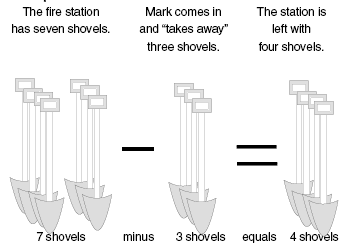1.3 Subtraction
1.3 Subtraction Anonymous (not verified)SUBTRACTION: COMPUTING A DIFFERENCE
Subtraction is used in two types of situations. The first is "How much is left?" and the second is "How much more is needed?" Some words used in subtraction are "minus", "take away", "less", and "difference".
Example 1 - How many are left?

In the figure above, the fire station has 7 shovels. Mark "takes away" 3 shovels. How many shovels are left?
Set up the problem as 7 shovels minus 3 shovels. The answer to 7 - 3 is 4 shovels.
SUBTRACTING LARGE NUMBERS
Example 2 - Subtracting numbers. Subtract 5342 from 9854.

As shown in the example above, first subtract the ones. Next, subtract the tens. Keeping moving from right to left, so next subtract the hundreds, and finally, subtract the thousands.
The answer to 9854 - 5342 is 4512.
"BORROWING" NUMBERS
As you subtract numbers in the ones, tens, hundreds, etc. position, you might find that the number being subtracted is larger than the one from which you are subtracting. In this case, "borrowing" from the next column to the left is necessary.
Example 3 - Subtract 932 minus 784.

First, subtract the number in the ones column. Because 4 cannot be taken away from 2, 1 ten must be borrowed to get 12 ones. Now take away 4 from 12 to get 8.
Move to the tens column. Because 8 cannot be taken away from 2, borrow 1 hundred to get 12 tens, and take away 8 from 12 to get 4.
Finally, we move to the hundreds column. There are 8 hundreds left and we will take away 7 to get 1.
The answer to 932 - 784 is 148.
SUBTRACTING SIGNED NUMBERS
Signs are important in subtracting numbers. Subtracting a negative number changes the sign of the number subtracted. When subtracting a negative number, the subtraction sign and negative sign together produce a positive number. Subtracting a negative number therefore has the result of adding a positive number. See the examples below.
7 - (-3) = ? becomes 7 + 3 = 10.
50 - (-20) = ? becomes 50 + 20 = 70
84 - (+26) = ? becomes 84 - 26 = 58
192 - (-301) = ? becomes 192 + 301 = 493
-50 - (-20) = ? becomes -50 + 20 = -30
In the last case, because a larger negative number (-50) was added to a smaller positive number (20), the end result was negative. See Chapter 1, Section 1.2 for more information on adding numbers of different signs.